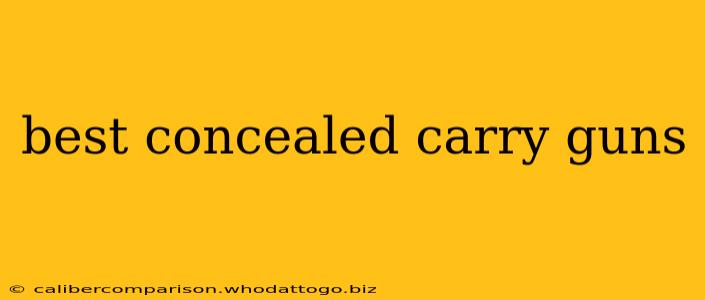Choosing the right concealed carry gun is a deeply personal decision, heavily influenced by individual factors like hand size, physical build, experience level, and lifestyle. There's no single "best" gun, but rather a range of excellent options depending on your specific needs and preferences. This guide will explore key considerations and highlight some top contenders in various categories. We'll delve beyond simple lists, providing in-depth analysis to help you make an informed choice.
Key Factors to Consider When Choosing a Concealed Carry Gun
Before diving into specific models, let's outline the crucial factors influencing your decision:
1. Caliber: Power vs. Shootability
The caliber (the diameter of the bullet) directly impacts stopping power and recoil. Larger calibers like .45 ACP offer greater stopping power but often generate more recoil, making them less suitable for smaller individuals or those new to firearms. Smaller calibers, such as 9mm, .380 ACP, or .40 S&W, offer a balance between manageable recoil and sufficient stopping power. Modern ammunition advancements have significantly improved the effectiveness of smaller calibers.
2. Size and Weight: Concealability and Comfort
Concealed carry hinges on the gun's size and weight. Smaller, lighter guns are easier to conceal but may compromise capacity and shootability. Larger guns offer more capacity and often better ergonomics, but can be more challenging to conceal and carry comfortably throughout the day. Consider your body type and clothing styles when assessing this aspect.
3. Capacity: Rounds per Magazine
The number of rounds a magazine holds directly impacts your defensive capability. Higher capacity magazines provide more shots before reloading, but they also contribute to the overall size and weight of the gun.
4. Ergonomics and Shootability: Comfort and Control
A gun that fits your hand well and is easy to control is crucial for accuracy and effectiveness under stress. Consider the grip texture, trigger pull, and overall feel of the gun. Practice with any potential purchase before making a final decision.
5. Reliability: Performance Under Pressure
Reliability is paramount in a self-defense firearm. Choose a gun known for its consistent performance, regardless of environmental conditions or ammunition type. Research reviews and seek opinions from experienced shooters.
Top Concealed Carry Gun Categories & Examples (2024)
While individual preferences dictate the "best" gun, we can categorize them to highlight strengths:
A. Subcompact Pistols: Maximum Concealability
These are designed for ultimate concealment. They are often smaller, lighter, and have lower capacity magazines.
- Examples: Sig Sauer P365, Glock 43X, Smith & Wesson Shield Plus. These are popular for their blend of concealability, shootability, and reliability. Research specific models within these lines as features vary.
B. Compact Pistols: Balance of Concealability and Capacity
Compact pistols offer a better balance between size, capacity, and shootability compared to subcompacts. They are a versatile choice for many users.
- Examples: Glock 19, Springfield XD-S MOD.2, SIG Sauer P320 Compact. These offer a good compromise, allowing for comfortable concealment while still providing sufficient rounds and manageable recoil.
C. Micro-Compact Pistols: Smallest Footprint
These are the smallest pistols, often prioritizing concealability above all else. Trade-offs in capacity and shootability are common.
- Examples: Ruger LCP II, Taurus G2C, Kel-Tec P3AT. These are excellent for pocket carry but often have limited features and capacity.
Beyond the Gun: Essential Considerations
- Holster Selection: A proper holster is critical for safe and comfortable concealed carry. Consider different holster types (IWB, OWB, Appendix Carry) and materials.
- Ammunition Selection: Choose high-quality self-defense ammunition appropriate for your gun and shooting style.
- Training: Regular practice and professional training are essential to safely and effectively use any firearm.

